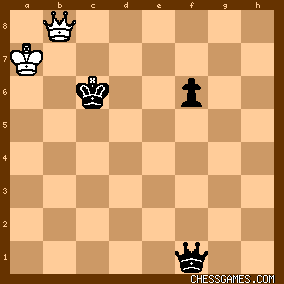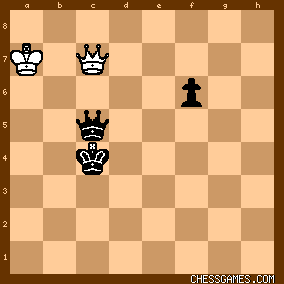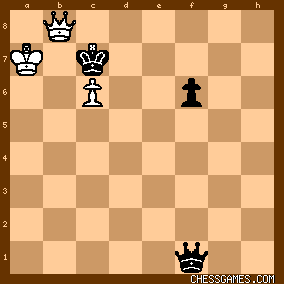|
< Earlier Kibitzing · PAGE 4 OF 4 ·
Later Kibitzing> |
| Nov-17-10 | | WhiteRook48: 56 Bxa7 |
|
| Nov-17-10 | | ruzon: Can anyone explain exactly how this is a draw from <Boster>'s position? When I tried against Crafty the Black king maneuvered down towards the lower right and eventually I got stuck in a place where I couldn't check. Every time that happens Black can move the pawn and start the clock over. |
|
Nov-17-10
 | | Phony Benoni: <ruzon: Can anyone explain exactly how this is a draw from <Boster>'s position? (after 56...Kxc6)>
click for larger viewNo, I can't. But I know it's a draw with White to play. You may have seen the "Nalimov" tablebase mentioned. This is a database of endgame positions with six pieces or less that a computer has solved. You can refer to it at: http://www.k4it.de/index.php?topic=.... It will list all the possible moves in a position and give you the outcome of each with perfect play. For example, in this position White draws with 57.Qa8+, 57.Qc8+, 57.Qe8+, 57.Qb7+, and 57.Qb6+. All other moves lose, including 57.Qb2 which holds out for 73 moves. ♕+♙ endgames are quite difficult to explain, at least for non-masters like me, because there are so few guideposts and general rules. For instance, "Two passed pawns on the sixth rank defeat a rook" is such a general rule. As we have seen today, the individual position must be examined to determine if it's an exception, but the guidepost makes finding a candidate move simpler. Here's one line of the draw after:
<57.Qa8+ Kd6 58.Qb8+ Ke6 59.Qc8+ Ke5 60.Qc7+ Ke4 61.Qb7+ Ke3 62.Qe7+ Kd3 63.Qd7+ Ke2 64.Qe7+ Kd2 65.Qd6+ Ke1 66.Qe6+ Kd1 67.Qd6+ Kc1 68.Qc6+ Kb1 69.Qb6+ Ka1 70.Qa6+ Qxa6+ 71.Kxa6 Kb2 72.Kb5 Kc3 73.Kc5 Kd3 74.Kd5 Ke3 75.Ke6 1/2-1/2> You can see what happens: White checks the Black king from afar along the sixth rank, keeping the pawn under attack. Black can't interpose his queen or move the king to the f-file without losing the pawn. He tries moving the king to a1, but then Qa6+ forces a queen trade in a position where White can grab the pawn before Black can protect or promote it. That's just one way, of course. You can use Nalimov to study the ending more carefully, and maybe come up with your own guideposts. Just for fun, here's the 73-move win.:
<57.Qb2 Qf4 58.Qb6+ Kd5 59.Qb5+ Ke6 60.Qb3+ Kf5 61.Qb1+ Qe4 62.Qg1 Kf4 63.Qf1+ Kg5 64.Qg1+ Kh5 65.Qh2+ Kg6 66.Qg3+ Kf7 67.Qb3+ Ke7 68.Qa3+ Kd7 69.Qb3 f5 70.Qh3 Qe6 71.Qd3+ Ke8 72.Qf3 Qe5 73.Qh5+ Kf8 74.Kb7 Qe4+ 75.Kc7 f4 76.Qh6+ Ke7 77.Qg5+ Ke6 78.Qg8+ Ke5 79.Qh8+ Kd5 80.Qa8+ Kd4 81.Qa1+ Kc4 82.Qa2+ Kc3 83.Qa3+ Kd2 84.Qa5+ Ke2 85.Qa2+ Ke3 86.Qa3+ Qd3 87.Qc1+ Qd2 88.Qg1+ Kd3 89.Qh1 Kc2 90.Qe4+ Kb3 91.Qe6+ Kb2 92.Qb6+ Kc2 93.Qg6+ Qd3 94.Qg2+ Kc3 95.Qf2 f3 96.Kb7 Kc4 97.Kb8 Qe2 98.Qb6 Qe5+ 99.Ka8 Qe4+ 100.Kb8 Qf4+ 101.Ka8 Qf8+ 102.Ka7 f2 103.Qe6+ Kd4 104.Qg4+ Kc3 105.Qg3+ Kb4 106.Qg4+ Ka3 107.Qh3+ Kb2 108.Qf1 Qf7+ 109.Ka6 Qf5 110.Ka7 Qc2 111.Qg2 Qa4+ 112.Kb7 Qb3+ 113.Kc7 Qc2+ 114.Kd6 Qe2 115.Qg7+ Kc2 116.Qc7+ Kd1 117.Qa7 Ke1 118.Kc6 Qe4+ 119.Kb6 Qd4+ 120.Kb7 Qxa7+ 121.Kxa7 Ke2 122.Kb7 Kd3 123.Ka7 f1Q 124.Kb7 Qf6 125.Ka7 Kd4 126.Kb7 Kc5 127.Ka7 Kc6 128.Ka8 Kb6 129.Kb8 Qf8# 0-1> |
|
| Nov-17-10 | | Zkid: <ruzon> If the King goes to the lower right (g1, g2, g3, h1, h2, h3) white checks on g6 and h6, when black's queen can't block (because white takes f6) and black can't go to the f file for the same reason. In general white just has to make logical checks, when because of the suboptimal place of black's queen they are inescapable. (You can confirm this to yourself at http://www.k4it.de/index.php?topic=...) My two cents:
In simplifed form. See below if you want refutations of alternative moves for either side.
58...Ra5+ 59. Kb4 Kd6 60. b7 Kc7 61. Kxa5 f3 62. Ka6 f2 63. Ka7 f1=Q 64. b8=Q+ is a fairly easy draw.
58...Ra1! 59. b7 Rc1+! 60. Kb6 Rb1+ 61. Kc5 f3 62. c7 f2 63. c8=Q f1=Q 64. b8=Q+ Rxb8 65. Qxb8+ is the best line for both sides. It looks like a draw since white has checks to start and the pawn has not gotten far, and this result is verified by the tablebase. However, this is black's best shot, it could be tricky. 57... f3? 58. b7 is completely lost.
57...Ra6? loses to both 58. b7 Rxc6+ (Rb6 c7) 59. Kb5 or 58. c7
57... Ra4+! is the most logical move, when 58. Kc5 is forced (all three other K moves lose to Kd6) and now:
58... Ra5+ is the simplest draw, and gives black some winning chances. Forced is: 59. Kb4 (Kc4? Kd6 0-1) Kd6 60. b7! (Kxa5? Kxc6 Ka6 f3 b7 f2 b8=Q f1=Q+ and white loses his queen) Kc7 61. Kxa5 f3 62. Ka6 f2 63. Ka7 f1=Q 64. b8=Q+ Kxc6 and white can give a perpetual without great difficulty.
58... Ra1! is also a draw. (these are the only two moves) 59. b7 (c7? Rc1+ and Kd6) Rc1+! (Rb1? c7 is just losing) 60. Kb6 Rb1+ (Black's idea: his rook holds the bpawn white black threatens Kd6) 61. Kc5! (the only move: 61. Kc7? Kd5 stops the pawns - Kd7 f3, all others lose to Kd6) and here black can repeat with Rc1+, but he has f3! 62. c7 f2 63. b8=Q f1=Q 64. c8=Q+ Rxb8 with good winning chances. Here the perpetual is harder (it IS a draw, verified by the tablebase, but this seems to have more chances) since white's king gets in the way of his queen. An interesting puzzle: if instead of 64. c8=Q+ white plays 64. Qe8+? Kf4! 65. c8=Q Rc1+ 66. Kd6 (the best square; all other moves lose more easily, as you can verify with the tablebase after Rxc8 Qxc8) Rxc8 67. Qxc8, what is black's unique winning move? (It's the move I would play. I would never have guessed this, but the tablebase knows all.) |
|
| Nov-17-10 | | Zkid: Edit of my last line: I meant it's NOT the move I would play. |
|
| Nov-17-10 | | 4tmac: Good stuff Zkid. That last unique win (& the followup for that matter) is all the more amazing since usually you don't want the ♕ on the edge. The ♔ you DO want out of the way. 
click for larger view I came across this which even though lost, there is a couple moves making the win very difficult. What's the BEST Move? |
|
| Nov-17-10 | | BOSTER: <Zkid> Thanks a lot for your perfect analysis.
Now I can study Q+p vs Q ending. |
|
| Nov-17-10 | | M.Hassan: <David 2009 60..Kxa5?? looses but 60.b7 gains the all-important tempo>:
I find it difficult to grasp that and for this reason, I have gone through the line again:
56.Bxa7 Rxa7 57.b6 Ra4+ 58.Kc5 Ra5+
59.Kb4 Kd6 60.b7! Kc7 61.Kxa5?? f3
62.Ka6 f2 63.Ka7 f1=Q 64.b8=Q+
And the resulting diagram is produced which I think its gone be draw agai[bad FEN: n1Q6/K1k5/2P2p2/8/8/8/8/5q2]
Am I missing anything. Will be nice to know your comments |
|
| Nov-17-10 | | M.Hassan: <David 2009>: Sorry that the diagram did not show. Don't know why. It says bad FEN. I am sure you can arrive to my ending as well. Thank you for your analysis and like to know your comments on this line. |
|
| Nov-17-10 | | M.Hassan: <BOSTER after 64....Kxc6 This looks like a draw> FULLY AGREED- Thanks for the support |
|
Nov-17-10
 | | al wazir: It seems I didn't earn three points after all. I gave 57...Ra4+ scant consideration, assuming that black would move the ♖ out of the way after 58. Kb5. White can't stop to capture the ♖: 58...f3 (58...Ra8 59. c7 Rc8 60. b7 Rxc7 61. b8=Q, pinning the ♖, and now black's f-♙ doesn't promote) 59. c7 f2 60. c8=Q f1=Q+ 61. Kxa4. At this point black has a lot of ways to check, but I think that white can hide his ♔ on the eighth rank and queen a second ♙ before black does. So it's two points for me and five so far this week. |
|
Nov-17-10
 | | Phony Benoni: <M.Hassan> [bad FEN: [bad FEN: n1Q6/K1k5/2P2p2/8/8/8/8/5q2]] That inadvertant "n" at the beginning of the first section is what produced the bad FEN message, as it made nine spaces on the rank instead of eight. Take it out, and you get this: 
click for larger viewI know this message well, through much experience. |
|
| Nov-18-10 | | turbo231: Got it and surprisingly the continuation also. Two connected pawns on the 6th rank can make life very unpleasant for a rook on the 7th rank. Especially on the b and c files. I'm not going to play against Hundini1.03 2 core and spoil everything. |
|
| Nov-18-10 | | ChessGeezer: Got it. My total score is 6 so far. |
|
Apr-15-14
 | | offramp: My score is also 6 so far. |
|
Apr-15-14
 | | FSR: All bets are off, indeed. Amazing that Black managed to lose this exchange-up ending. |
|
| Apr-15-14 | | SpiritedReposte: Nice finesse at the end ignoring the rook in order to queen with check. |
|
Apr-15-14
 | | Richard Taylor: Black was winning up to near the end. (Well according to my quick look, but maybe I assessed it all wrong, these endings can be tricky. But such is the reality of OTB chess. |
|
Apr-15-14
 | | FSR: <Richard Taylor> On November 17, 2010 comments, <wals> and others posted quite a few comments showing the many many improvements for Black. As you say, Black was winning for a long time, and was still drawing until 57...f3?? (57...Ra4+!). He must have been kicking himself for a long time after this game. |
|
| Apr-15-14 | | kevin86: Two advanced pawns can conquer a rook with no other pieces around. |
|
| Apr-15-14 | | raju17: 37...bd2 wins for black. |
|
| Apr-15-14 | | yureesystem: This is what makes chess a hard game, sometime pawn are stronger than a rook. Just because you are winning a exchange doesn't mean you are ahead in material. In one my game, I can win the exchange but he gets a better pawn structure and active rook and his bishop work well with his rook. My major pieces are just defending pawns. I reject winning his rook and found another plan. Chess is a very difficult game, winning five points to three points doesn't mean you are winning material. |
|
Apr-15-14
 | | FSR: <kevin86: Two advanced pawns can conquer a rook with no other pieces around.> Yes. In general, two connected passed pawns on the sixth rank beat a rook. E.g., Szen vs S Newham, 1851 (although the side with the R should take one of the pawns and then make the other guy prove that he can win Q v. R, instead of resigning as Newham did). But see Keres vs E Eliskases, 1938, where Keres used mating threats to force a draw by repetition against two connected passers on the <seventh> rank - analyzed by me at http://bit.ly/1qYScJu. Amazingly, I got the exact same position and held the draw in a "standard" game I played on FICS some years ago. |
|
| Apr-15-14 | | Gambit86: Instead of 32...Nd2 I saw 32...Nc3 threatening mate on a2 and the queen, bxc3 33.Bxc3+ Bb2 34.Rd2 and that seems to win. Black had all his pieces headed right for the white king, it was a good attack. Nd2 was too slow |
|
| Apr-15-14 | | dark.horse: A duo on the sixth rank is a tough nut for a rook to handle. |
|
 |
 |
|
< Earlier Kibitzing · PAGE 4 OF 4 ·
Later Kibitzing> |





